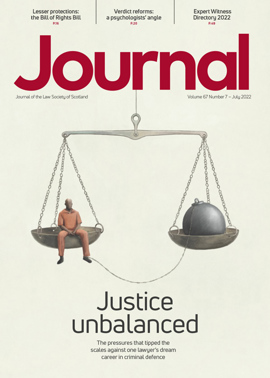From beer to bones
90 years on from the “snail in the bottle” case, and Scottish product liability cases continue to occupy the minds of the UK Supreme Court.
The seminal judgment in Donoghue v Stevenson, delivered by (what was then) the UK House of Lords in May 1932, laid the foundation for the modern law of negligence and established the principles of the duty of care.
It involved a decomposed snail in the bottom of a bottle of ginger beer, drunk by Mrs Donoghue, but crucially purchased by her friend, at a café in Scotland. The House of Lords issued a groundbreaking decision that a duty of care could exist outside of a contract.
What’s happened now
Fast forward to June 2022, which saw a rare UK Supreme Court decision in the same area of product liability, Hastings (Appellant) v Finsbury Orthopaedics Ltd [2022] UKSC 19, again on appeal from the Scottish courts.
This judgment related to a metal-on-metal hip prosthesis manufactured by Finsbury Orthopaedics, part of De Puy/Johnson & Johnson. Hip replacement surgery involves a damaged hip joint being replaced with an artificial one.
The law having moved on from 1932, the case was founded on the UK Consumer Protection Act, which introduced a strict liability regime for defects in products sold to consumers.
In this case, the pursuer/appellant had failed at first instance, and on appeal in Scotland, to prove that the product was defective.
The Supreme Court agreed. The Justices said they had no basis for overturning the first instance judge’s findings of fact. As such, the original judgment stands, and the pursuer failed to establish that the product was defective.
Entitled expectation test
The Supreme Court gives somewhat short shrift to the claimant. However, the judgment is useful in summarising the recent line of cases regarding entitled expectation and the recent UK cases of Wilkes and Gee.
It summarises that the test of whether a product is defective is not what is expected by the particular individual, but one of entitled expectation, objectively measured by what the public at large is entitled to expect. The circumstances that can be taken into account in considering this, and the assessment of risks associated with a product, are to be evaluated as at the time of supply and not with hindsight. However, in determining whether a product meets the required level of safety, a court can take into account everything now known, including information that has subsequently come to light.
Data analysis and historical context
The judgment is interesting in the degree of reliance placed at first instance on Finsbury’s statistical expert, and the extent to which the expert persuaded the original judge to go behind the data and understand its flaws. Also, its historical setting was examined. The pursuer argued that the withdrawal of the product was evidence of defect, as were alerts and notices issued by the regulator and the manufacturer. However, Finsbury successfully demonstrated that the withdrawal was done for commercial reasons which did not support a finding of defect. In addition, the first instance judge accepted evidence from Finsbury’s statistical expert who challenged the information on which the alerts and notices were based.
Consumer protection under European law
The pursuer also expanded on a series of more general arguments on appeal around the purpose of the UK Consumer Protection Act and the underlying European Product Liability Directive from which that derived. In particular, he said the judge’s approach was contrary to the principle of effectiveness in EU law and had made it excessively difficult to prove defect. The pursuer said he had effectively been required to prove his case by statistics, given that scientific evidence on the performance of the product was scarce due to its lack of time on the market. He further argued that the directive should be interpreted in favour of the consumer, as that was in line with its stated objective of consumer protection. As such, the judge should be able to draw an inference from the withdrawal of the product from the market, or at least preclude the manufacturer from taking advantage of the withdrawal, which meant that data on the product was limited. Lastly, the pursuer argued that the principles of fairness and common sense called for a benevolent application of the Act, again based on the lack of available data.
However, while these would have proved interesting arguments to consider, the Supreme Court did not do so given its principal finding. These points therefore remain untested.
Perspectives
Features
Briefings
- Civil court: Issues on appeal
- Licensing: Minimum pricing – a genuine impact?
- Insolvency: How to admit joint creditor claims
- Tax: windfall and plastic packaging taxes raise stakes
- Immigration: Asylum system overhauled
- Scottish Solicitors' Discipline Tribunal: July 2022
- In-house: In with the stonework
- Property: Living with the Register of Overseas Entities
In practice
- OPG update: July 2022
- Public policy highlights: July 2022
- Gear up for the Scottish Legal Walks
- Disabled solicitor support group proposed
- Risk: Cybercrime – the hybrid worker prey
- Ask Ash: Piling it on
- TRS: time for a trusts trawl
- Know people, know business
- High street and hybrid
- Appreciation: Ian Leslie Shaw Balfour
- The Expert Witness Directory 2022
- Expert witness: case law update






